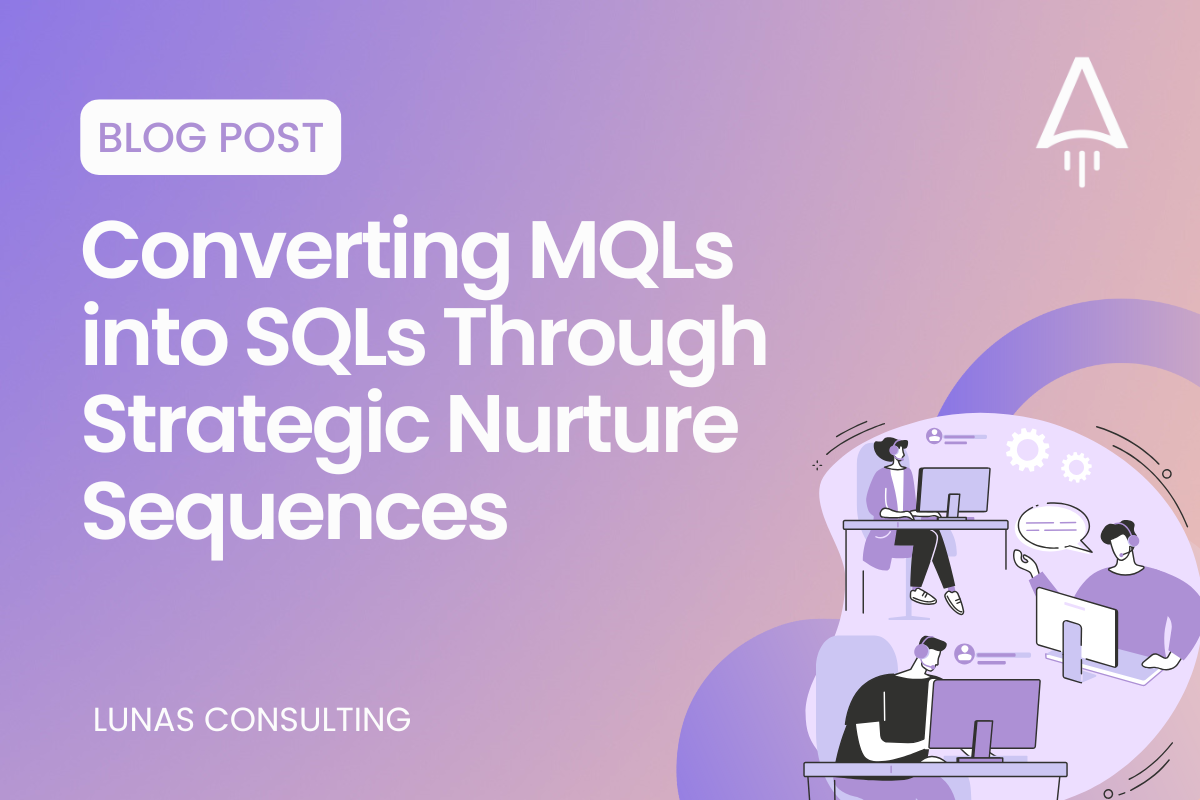Converting MQLs into SQLs Through Strategic Nurture Sequences
From qualification frameworks through measurement strategis, learn to bridge the critical gap between marketing and sales.
From qualification frameworks through measurement strategis, learn to bridge the critical gap between marketing and sales.

Companies with structured MQL-to-SQL nurture sequences consistently outperform those relying on basic lead handoffs. The difference lies not in lead quality but in systematic progression strategies that prepare prospects for sales conversations.
The challenge of the critical handoff between marketing and sales creates friction that loses valuable opportunities. Marketing generates leads that sales deems unready. Sales complains about lead quality while marketing points to volume targets. Meanwhile, potential customers fall through the gaps, frustrated by misaligned experiences.
This guide provides proven strategies for seamless lead progression from initial interest to sales readiness. Through structured nurture sequences and aligned processes, you'll learn to transform raw MQLs into SQLs that sales teams eagerly pursue. Let's explore how strategic nurturing bridges the qualification gap.
The journey from Marketing Qualified Lead to Sales Qualified Lead represents a critical transformation in buyer readiness. Understanding this transition enables effective nurture strategy development.
Marketing Qualified Leads emerge when prospects demonstrate interest beyond casual browsing. They've typically engaged with multiple marketing touchpoints—perhaps downloading an ebook, attending a webinar, and returning to your website several times. These behaviors signal genuine interest but don't guarantee readiness for sales conversations.
Sales Qualified Leads show clear buying signals. They've moved beyond general education to specific evaluation. An SQL has typically identified a budget for a solution, involved other stakeholders in the process, and established a timeline for making a decision. They're comparing specific vendors rather than researching whether they need a solution at all.

The qualification gap creates handoff challenges that plague many organizations. Marketing might consider a lead qualified after three content downloads, while sales expects leads who are ready to discuss pricing and implementation. This misalignment leads to finger-pointing, with marketing claiming sales doesn't follow up properly and sales arguing that marketing sends junk leads.
Effective qualification frameworks provide objective criteria for lead progression, eliminating guesswork and friction in the MQL to SQL journey.
Strong MQL criteria balance behavioral signals with demographic fit. Look for patterns of engagement rather than single actions:
Demographic factors also matter. A Fortune 500 company engaging with enterprise content represents a stronger MQL than a small business consuming the same material if you target enterprise buyers.
SQL indicators dig deeper into buying readiness. The classic BANT framework provides a foundation, but modern indicators include:
Lead scoring quantifies qualification through point systems. A webinar attendance might earn 10 points while a pricing page visit earns 15, reflecting stronger buying intent. Set thresholds based on historical conversion data—if leads typically convert to SQL around 75 points, that becomes your threshold.

Progressive qualification stages create stepping stones rather than binary MQL/SQL states. Think of it as a maturity model where leads advance through increasing engagement and qualification levels.
Understanding typical progression patterns enables optimized nurture sequence design that matches content to mindset at each stage.
Conversion timelines vary dramatically by solution complexity. Simple SaaS tools might see 2-4 week progressions, while enterprise software often requires 3-6 months of education and consensus building. Professional services typically fall between at 1-3 months.
Awareness Stage: Prospects need problem education
Interest Stage: Focus shifts to solution exploration
Consideration Stage: Validation becomes critical
Intent Stage: Enable decision-making
Common drop-off points occur at predictable moments. Many leads disappear after initial downloads without quick follow-up value. The shift from education to solution introduction loses others if pushed too aggressively. Understanding these patterns helps design sequences that guide rather than push.
Strategic sequence design transforms casual interest into qualified opportunities through systematic progression.
The architecture follows natural buying behavior. Welcome emails set expectations while delivering immediate value. Educational content builds problem awareness without mentioning solutions. Only after establishing need do you introduce approaches, followed by validation and decision support.
Each sequence element should provide standalone value while advancing the conversation:

This value-first approach builds trust and investment. Prospects who spend time with your calculator or complete your assessment have skin in the game, making them more likely to continue engaging.
Objection handling gets woven throughout rather than saved for sales calls. If implementation complexity commonly concerns prospects, address it during nurture. If pricing creates sticker shock, build value understanding before revealing costs.
A tip from us: Map nurture content directly to sales objections. If sales reports prospects worry about integration challenges, create content addressing this during nurture. This alignment means leads arrive at sales with major concerns already resolved.
Content effectiveness varies dramatically based on lead maturity, requiring different approaches as prospects progress.
Focus on education without selling. Industry trend reports work well, especially those highlighting challenges without pushing products. Expert interviews provide third-party validation of problems you solve. Assessment tools help prospects self-diagnose issues, making problems tangible and personal.
The key is building problem awareness and urgency without appearing self-serving. Think of it as helping prospects sell themselves on needing change before you ever pitch solutions.
Shift focus from problems to solution categories while maintaining educational value:
This content subtly positions you as the expert who happens to offer one of the solutions discussed.
Directly address buying readiness with:
Coordinated multi-channel strategies meet prospects where they prefer to communicate while reinforcing messages across touchpoints.
Email remains the nurture backbone, providing reliable content delivery. But email alone feels one-dimensional in today's multi-channel world. LinkedIn adds professional context for thought leadership and peer-to-peer connection. Retargeting maintains visibility between direct touches. Strategic phone calls add human elements at high-value moments.
Each channel should complement others rather than duplicate:

The key is progressive messaging across channels. Someone who downloaded your beginner's guide might see retargeting ads for your intermediate guide, receive emails with advanced insights, and get LinkedIn invitations to exclusive webinars.
Sophisticated scoring enables precise qualification while progressive profiling builds intelligence without overwhelming prospects.
Focus on behaviors that truly indicate progression:
Email opens alone mean little, but clicking through to spend 10 minutes with your ROI calculator signals serious interest.
Start simple and build profiles over time:
This approach respects prospects' time while building complete pictures for personalization and qualification.
A tip from us: Calibrate scoring quarterly using actual SQL conversion data. That piece of content you thought indicated serious interest might attract tire-kickers, while seemingly minor actions like reading your implementation guide could strongly predict buying readiness.
Successful MQL to SQL conversion requires genuine collaboration between traditionally siloed teams.
Service Level Agreements create mutual accountability. Marketing commits to specific lead quality standards—perhaps 100 MQLs monthly meeting defined criteria. Sales commits to follow-up timeframes and attempt minimums before disqualification. Both agree on SQL definitions and edge case handling.

Smooth transitions require more than automated alerts:
Regular feedback loops enable continuous improvement. Weekly lead reviews examine why certain MQLs didn't convert and which content actually influences deals. This isn't about blame but about learning and optimizing.
Comprehensive measurement reveals true business impact beyond surface metrics.
Key performance indicators should connect to business outcomes:
Attribution modeling helps understand nurture's contribution throughout the journey. While last-touch might credit the final email, multi-touch models reveal cumulative impact. Choose models matching your sales cycle complexity.
ROI calculations justify investment by comparing fully-loaded program costs against revenue lift from nurtured leads. Include differences in deal size, close rate, and customer lifetime value for complete pictures.
Long-term success requires scalable processes maintaining quality while accommodating growth.
Strategic program development looks beyond immediate conversions. Build segment-specific paths acknowledging different audiences need different journeys. Plan for seasonal variations, technology changes, and team growth from the start.

Team structure should clarify roles while enabling collaboration. Content creators need buyer journey understanding, not just writing skills. Sequence managers balance automation with personalization. Analysts connect data to actionable insights.
Build for growth from the beginning:
Budget allocation balances content creation, technology, training, and potential external expertise. Remember that great content in a poor system fails just as surely as poor content in a great system.
Effective MQL to SQL nurture sequences transform traditionally problematic handoffs into smooth progressions serving both team and buyer needs. Success requires aligned definitions, valuable content, systematic processes, and continuous optimization based on real data.
The journey from MQL to SQL mirrors the buyer's journey from problem awareness to solution evaluation. By understanding and supporting this progression rather than fighting it, organizations create sustainable systems for converting interest into sales-ready opportunities.

Start with clear definitions both teams accept. Build sequences providing genuine value while progressively qualifying. Measure what matters and optimize based on results. Most importantly, remember that nurture is about helping buyers buy, not pushing products.
Interested in improving your skills and learning more about business operations to generate and convert leads? Check out the following articles:
Essential Online Presence Tools Every Business Owner Should Use in 2025
Why Small Businesses Need a Strong Online Presence to Survive and Thrive
How Your Online Presence Functions as Your Most Powerful Business Card
Building a Loyal Online Following Through Strategic Social Media Consistency
How Social Media Transforms Your Digital Strategy and Online Business Growth
10 Time-Saving Strategies for Effective Business Updates Across Social Media Platforms
We have a lot more for you. Click the button below to sign up and get notified when we release more content!
View more